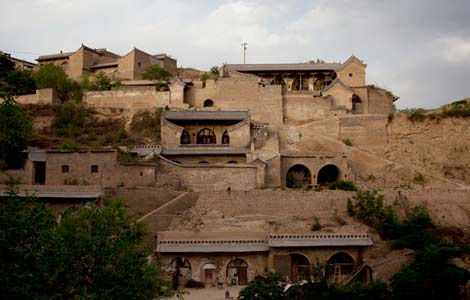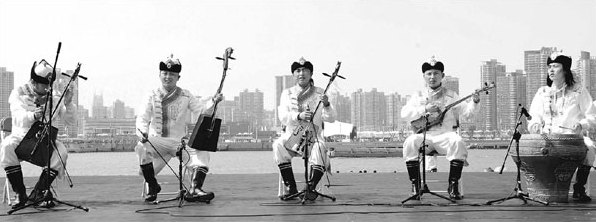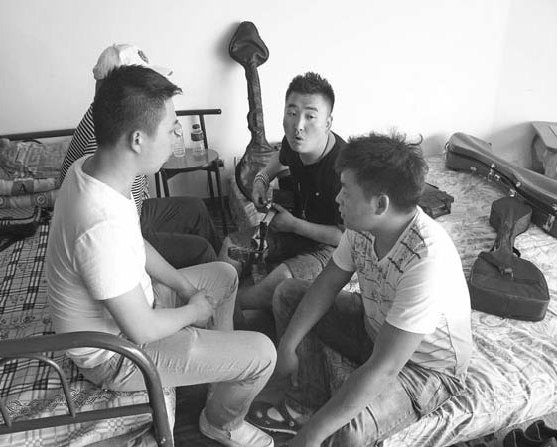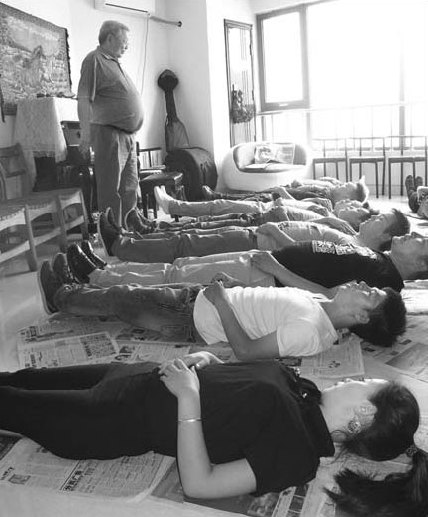Voice of tradition
Updated: 2013-07-11 07:31
By Wang Kaihao (China Daily)
|
||||||||
|
Khoomei singers from the Inner Mongolia autonomous region gave a performance at the 2010 Shanghai World Expo. Yang Shirao / Xinhua |
|
Durenjana (second from right) practices Khoomei with his companions living in an attic in Hohhot, the Inner Mongolia autonomous region. |
|
Under the guidance of Od Suren, students start their Khoomei class practicing breathing exercise at Od Suren Khoomei School in Hohhot. Photos by Wang Kaihao / China Daily |
A school in the Inner Mongolia autonomous region ensures the ancient sounds of throat singing reverberates through the past and into the future. Wang Kaihao reports in Hohhot.
Durenjana and his three friends get stares when they bleat from their throats as they walk through crowded shopping malls.
It's not immediately apparent to onlookers that the 25-year-old and his companions are seizing a rare chance to practice the ancient performing art of Mongolian throat singing in the mall in the Inner Mongolia autonomous region's capital Hohhot.
"I have to practice whenever I can," Durenjana says.
"That's what I come here for."
He has spent the past five years studying Khoomei, an ancient throat-singing technique of ethnic Mongolians and Tuvans. He has performed on China Central Television but still calls himself an amateur.
One or more pitches sound simultaneously over a fundamental pitch in Khoomei.
Khoomei's origins are uncertain. But it is generally believed to have derived from herders' imitations of animal sounds and to have later been incorporated by lamas into religious rituals.
It's the first day of a new semester at Od Suren Khoomei School, which is located in a roughly 60-square-meter office. The first few minutes resemble a yoga class, as more than 20 students enter the room and lie on the ground. On their backs, they raise their heads and stretch their legs while chanting.
"It's physical exercise," Durenjana says.
"But it's essential to control your breathing when singing Khoomei."
Durenjana comes from Xilinhot, capital of Xilin Gol League in the north of Inner Mongolia, about 600 km from Hohhot.
Durenjana and the three men rent an office's attic for 200 yuan ($33) each a month.
They eat, sleep and - literally - breathe Khoomei during the three-week course. All four run 3 km a night to build up their lung capacity.
Their 65-year-old teacher Od Suren is from Mongolia. He's the deputy director of Mongolia's National Khoomei Association and among the world's leading educators of the art. He introduced the throat-singing tradition to his country's university syllabus.
Od Suren first visited China in 1993 and enrolled six students to learn this nearly vanished skill. He has taught more than 1,000 Chinese students since. Many of the autonomous region's top Khoomei singers are his former students.
Khoomei was placed on the UNESCO Intangible Cultural Heritage List in 2009, representing China rather than Od Suren's homeland.
This has earned the ire of some of Od Suren's compatriots. But he continues to spread this traditional music globally and is rarely drawn on the cross-border barbs.
"We've attracted so many young people," he says.
"That's what's important to me."
Od Suren's only ethnic Han student currently studying is 31-year-old traditional Chinese medicine doctor Zhang Li, who has come from Beijing.
Zhang says the fact he doesn't understand Mongolian doesn't negate his comprehension of the melodies' emotions.
"I'm lucky to have a nice teacher who tolerates my poor performance," he says.
Zhang became fascinated by Khoomei when he met a singer in a remote Tuvan village in the Xinjiang Uygur autonomous region in 2003. He has since sporadically learned it from musician friends.
"I don't know of any such regimented Khoomei class in Beijing," Zhang says.
Zhang has taken leave from his job to attend full time. "Khoomei was sung by ancient Shamanism priests, who were also doctors. So I believe it has medical value."
Many rock bands incorporate Khoomei in their acts. But Od Suren believes the tradition should remain in a pure form.
"Modern music can only borrow some elements from Khoomei," he says.
"Authentic Khoomei never changes. It comes from nature."
That's why he often gives lessons on the mountains that crest Hohhot's northern fringe. "Students get closer to nature there," he says.
Temur, a Hohhot-native Khoomei vocalist who launched the school in 2011, says there are two other teachers from Mongolia maintaining regular curriculums based on students' levels. But Od Suren provides all students with a solid foundation.
"Basic skills won't take too long for someone who wants to become professional," Temur says.
"Ethnic music's essentials must be upgraded. Then the rest can follow."
Hohhot held Inner Mongolia's first Khoomei contest in 2011. But the event was eventually suspended for lack of sponsorship.
Temur says the Xilin Gol League stages the only Khoomei contest. He hopes to get more areas involved in promoting the folk art.
He is glad more than 200 students have attended the school in the past two years.
"It's important Khoomei gains popular appeal, but we also expect to nurture masters here," he explains.
He takes hope in newcomers such as Namla. The 22-year-old recently graduated as a film major. But rather than look for a job, she became one of two female students in his class.
"I want to grasp these unique skills before I consider something more practical," she says.
"My career will be easier if I can sing Khoomei," she says.
"But for now it costs money and time. I've yet to see the return."
It's more difficult for women than men to perform the singing style because of the differences in their vocal cord.
Female performers were virtually unheard of in old times. But Od Suren has brought several into the tradition.
"It will be tougher for me," Namla says.
"But I could be the next star."
Contact the writer at wangkaihao@chinadaily.com.cn.
(China Daily USA 07/11/2013 page10)

 China investigates GSK executives for bribery
China investigates GSK executives for bribery
 China, Russia complete 3-day joint naval drill
China, Russia complete 3-day joint naval drill
 US drone completes 1st carrier landing
US drone completes 1st carrier landing
 Sino-US talks 'help build trust'
Sino-US talks 'help build trust'
 Boston Marathon bombing suspect pleads not guilty
Boston Marathon bombing suspect pleads not guilty
 Caution urged in seeking experts from abroad
Caution urged in seeking experts from abroad
 Shanghai struggles with growth
Shanghai struggles with growth
 Trade town turns to tourism
Trade town turns to tourism
Most Viewed
Editor's Picks

|

|

|

|

|

|
Today's Top News
Senators skeptical about Smithfield deal
Beijing has world's most delayed airport
Caution urged in seeking experts from abroad
Snowden is likely Venezuela bound
Talks 'help build trust' between China, US
Obama pushes House Republicans on immigration
Chinese researcher pleads guilty in US drug case
US Navy completes 1st unmanned carrier landing
US Weekly

|

|








